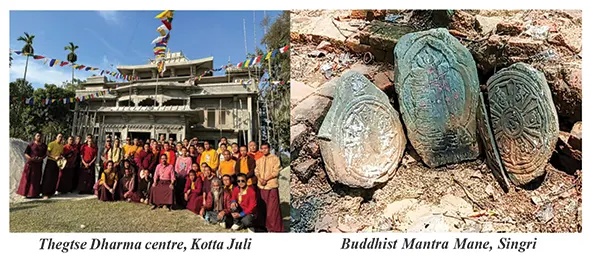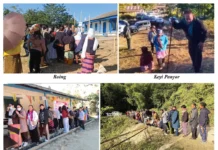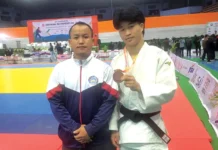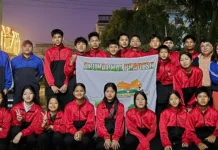[ Prem Chetry ]
BOMDILA, 21 May: One of the prominent Buddhist spiritual leaders Padma Shri His Eminence, the 14th Thegtse Rinpoche of Khinmey Monastery from Khinmey village in Tawang district, is retracing the spiritual paths of his predecessors in Singri village in Assam’s Sonitpur district.
The Gupteshwar Temple on Singri Hill, situated on the bank of the Brahmaputra River, has been revered by Tibetans, Bhutanese, and Monpas of West Kamneg and Tawang districts for centuries.
Thegtse Rinpoche said, “Singri is one of the important pilgrimage sites for Monpas, Tibetans, and Bhutanese. Some prominent Buddhist spiritual leaders, including my two predecessors, frequently visited this place.”
He emphasized the need for extensive research in these areas associated with their religion and relationships with the people of Assam, stating that it would help preserve and promote the religion while also renewing centuries-old spiritual and cultural bonds.
At the behest of the Tamang community, the Rinpoche has established the Thegtse Dharma Centre at Kotta Juli near Singri.
The centre, started two years ago, aims to provide a learning platform for Dharma followers and is expected to be completed by 2026, he added.
Oral accounts from elders in Phudung village, West Kameng district suggest that the 12th and 13th Thegtse Rinpoches–Namgye Tsering and Yeshe Zangpo–visited Singri village annually during the 18th and 19th centuries.
Prior to the colonial period, the Monpas of West Kameng and Tawang districts used to visit Bhairabkunda Temple near Bhairabkunda in Udalguri district, and Singri in Sonitpur district, for trade and pilgrimage tours, mostly during winter.
Since time immemorial, the Monpas have referred to the plains of Assam as Tsongsa, where “Tsong” means “trade” and “Sa” means “land,” collectively translating to “Land of Trade.”
Historical references indicate that Thangtong Gyalpo, popularly known as Lama Chag Zhampa, a 13th-century Tibetan Buddhist adept, yogi, architect, and impresario, built numerous iron chain suspension bridges in Tibet, Bhutan, and Tawang, which are still surviving.
He also visited and mentioned the existence of a Buddhist stupa at Singri village. Further supporting this account, some “manes”- stone slabs inscribed with Buddhist mantras – still exist on the hillock of Singri.
In the 18th century, Terton Jigmey Lingpa, a renowned Nyingma master, traveled and taught in Monyul regions, leaving a significant Nyingma influence before the introduction of the Gelugpa School.
According to this master, Singri has been an important pilgrimage centre for Himalayan Buddhists since the 14th century.
Meanwhile, Dr. Yeshi Gyesen, principal of Dorjee Khandu Government College, Tawang, confirmed the existence of a monastery at Singri, sharing a personal account.
His mother, late Sange Chozom, during her teenage years, often accompanied her father, late Tsorgan (Gaon Burah) Langa Dorjee of Khaso village, under Dirang Sub-division, to Singri.
His mother often spoke of a monastery and sculpted objects that existed at Singri. Notably, Gaon Burah Dorjee was a prominent figure of his time, frequently traveling to the plains of Assam and Tsona province in Tibet for official purposes and trade as well.




